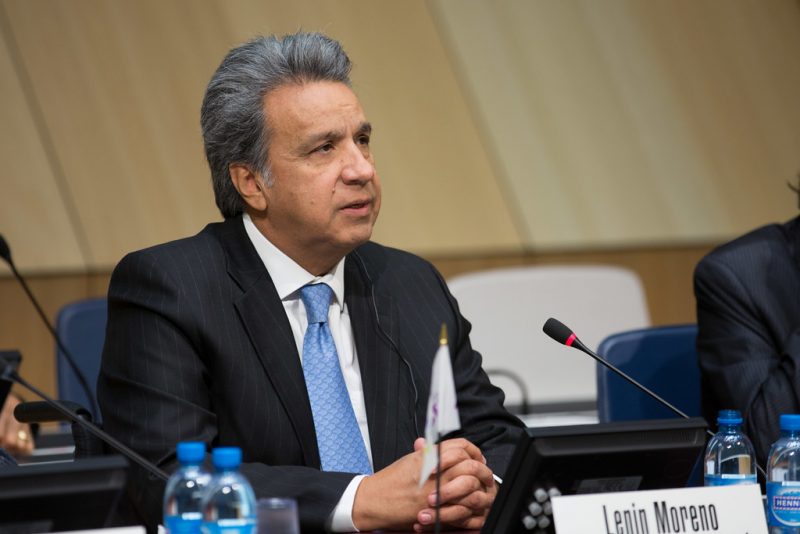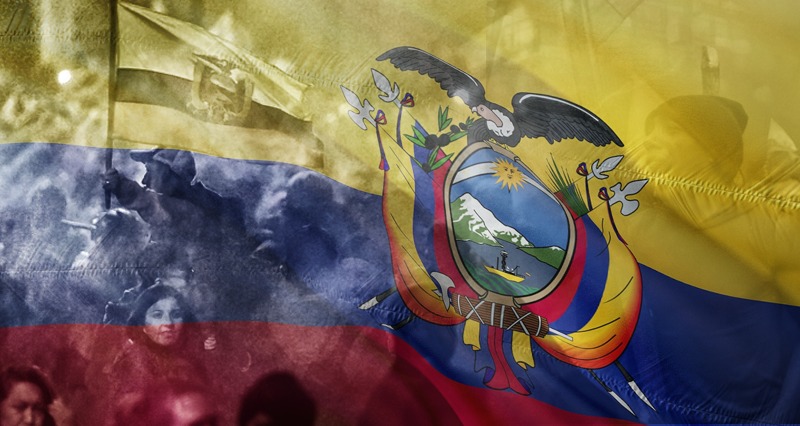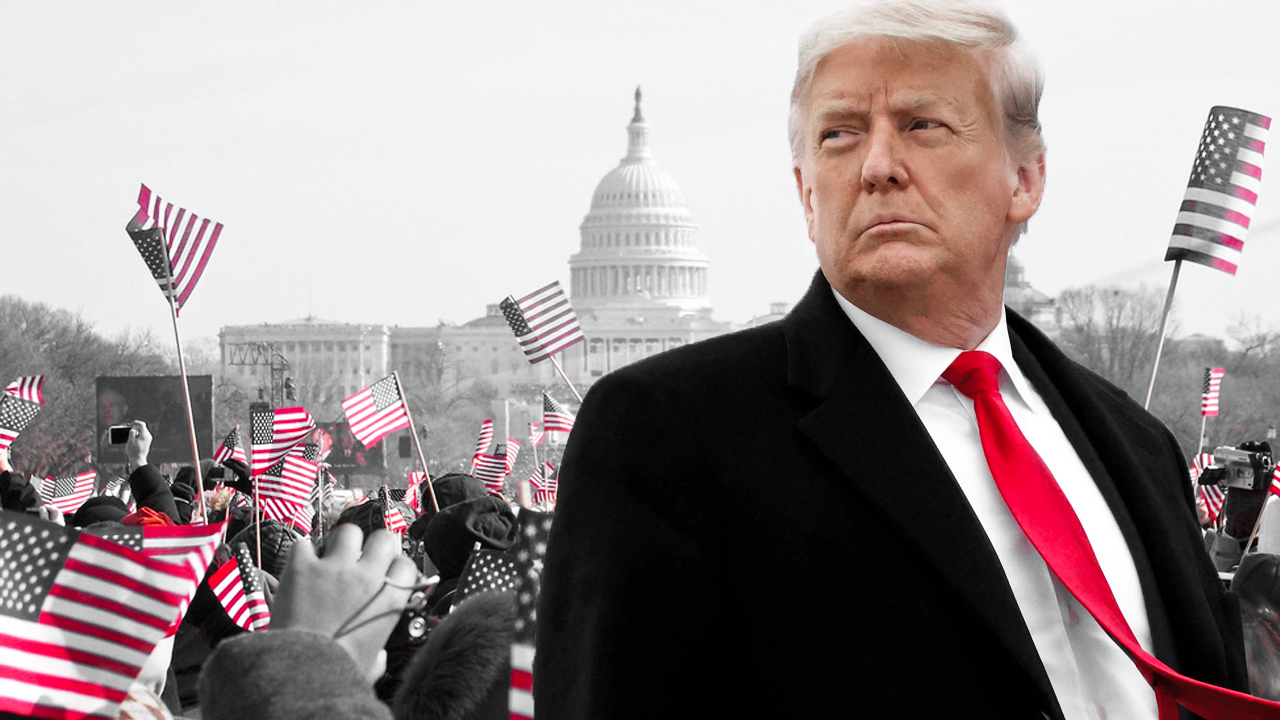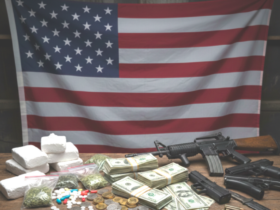In 2017, Lenin Moreno won the presidential elections in Ecuador with a program of a progressive government, continuing the line of former President Rafael Correa (2007-2017). But after a few weeks in office, he began to take unpopular measures, moving away from his electoral program and beginning a dialogue with sectors that represented the interests of banks and big business. As a result of those meetings, he forgave $4.6 billion in taxes and debt. After that, President Moreno began to look for sources of money to finance the next State budget.
The road to social upheaval
Moreno has begun a radical neoliberal program starting with taxes on super gasoline, claiming that it is the most expensive form of fuel and therefore mostly used by the rich. He claims that this action was not part of a paquetazo and was only an isolated hike. His words, however, were somewhat undermined when lack of finances forced him to ask the IMF for $4.2 billion dollars in credit. The IMF granted him the loan, but, as usual, the loan came with a series of conditions which must be met in order to “optimize the economy”, ie Moreno must impose neoliberal cuts to social welfare. To receive the first $1.2 billion, a series of measures had to be taken which began with a VAT increase (12% for all Ecuadorians)… however, social unrest broke out and forced the government to withdraw the measure and come up with another package of reforms. This is key to understanding the massive protests that have shaken Ecuador since October 3rd, 2019.
Moreno’s government has put out its package of reforms in two measures:
1) Liberalization of the prices in hydrocarbons, diesel, extra gasoline, and eco-país, by executive decree of the President (Decree 883). This measure entails that subsidies will be eliminated and prices will be set by the international market. As an example, a liter of diesel went up from $1.07 to $2.37, an over 100% increase. In Ecuador, people believe that as citizens of an oil-producing country, they deserve this subsidy which has been in place since oil was discovered in Ecuador in the early 1970s. The government points out, on the one hand, that the subsidy is inefficient and deprives the State of the necessary funds, and on the other, that Ecuador continues to have some of the cheapest fuel in South America regardless.
2) The economic and labor reform measures sent to Parliament by President Moreno filled as a response to economic emergency, which meant that they had to be dealt with within 30 days. If Parliament did not take action, the measures automatically go into effect as written by the president. The most important measures were the following:
- VAT increase: Raised again despite strong criticism from the right-wing, leaving the President without a majority in Parliament. Strong popular reactions broke out, eventually leading to the measures being withdrawn.
- Public servants: Reduction of holidays from 30 to 15 days. In addition, public servants have to donate one day of their monthly salary to the State. Despite that there had already been 11,000 layoffs since 2017, it has now been announced that almost 10,000 more are on the horizon, and those pending contract renewals will receive 20% less salary.
- Elimination of export taxes. Ecuador is a dollarized economy and this measure would very likely put the country into economic crisis.
- Elimination of the income tax that each businessmen must pay.
- Reduction of taxes on computers, tablets and telephones (a measure initiated to attempt to show that the government is still on the side of the people).
- “Labor improvements“: While this proposal is entitled “improvements in hiring”, in reality it means increasing precarious employment. Among these measures is the introduction of “flexibilization of working hours”, which will make the 40 weekly hours of workers between Monday and Friday possible to be scheduled at any time, be it Saturday, Sunday, or nights, without overtime bonuses. “Flexibilization of the contract” is another measure which eliminates the trial contract of 3 months that had to be followed by an indefinite contract in order to allow the employer to fire or lay-off employees more easily. It also eliminated required compensation for dismissals.
Protests Begin
On Thursday, October 3, Decree 883 was approved triggering protests and a general strike in the transport sector. The Government tried to discredit the demonstrations by pointing out that they had fines and that they did not pay taxes, etc., but the strike continued. On October 4th the Government insisted on dialogue with the transport sector and made some concessions such as reductions on other taxes that affect them directly. However, at this point, workers from other industries and students joined in as well. Most notably, however, indigenous people organized in the CONAIE (Confederation of Indigenous Nationalities of Ecuador) began to take part, knowing that if the price of fuel goes up, then the price of everything else will as well. On October 5, the transport workers withdrew from the protests, at which point the government thought that the other protestors would follow suite. They were wrong.

Pixabay
More and more Indigenous people from all the country’s provinces began to arrive in Quito, the Ecuadorian capital, to join the protests. The Government was frightened and issued a State of emergency, militarizing the entire country so that indigenous people could not get from the provinces to Quito. Authorities tried to stop the protesters by deploying the police and the military but the indigenous people manage to cross the blockade and reach Quito.
The government panicked and took emergency measures transferring the capital from Quito to Guayaquil (the most important coastal city and the second largest city in the country). The measure was likely informed by the fact that over the last 21 years three Presidents have been deposed when the Parliament and the Government Palace were occupied by demonstrators. The President ordered the closure of the Government Palace which remains guarded by the police and army while he fled to Guayaquil, and protesters failed to break through. Around 2,000 people attempted to storm the country’s Parliament as well, but were brutally repressed by the police.
The Government then issued a new decree imposing a curfew, prohibiting the free movement of citizens between 8:00 PM to 5:00 AM. This was only a partial measure affecting the area of the Parliament, Government Palace, Ministries and strategic zones such as the areas around oil facilities. However, more indigenous people from all over Ecuador continue to arrive in Quito.
The country’s largest universities opened their buildings to give refuge to the indigenous people arriving in the city. Others stayed at the Casa de la Cultura (House of Culture) located near the Parliament. After 8.00 PM, the Government initiated brutal repression to expel all the people who remained in the area, dropping tear gas bombs in the places where the protesters had taken refuge, even in the Eugenio Espejo public hospital which is one of the largest in Ecuador. Police have also brutalized the indigenous fleeing the reception areas of the universities.

Wikipedia
Deaths, injuries and detainees
In the course of the police persecution one indigenous leader was killed while another demonstrator was slain when he was run over by a police vehicle. The tension continued to elevate after the Minister of Government attempted to excuse the incidents by saying they were accidents unrelated to police actions. National television stations broadcast government messages declaring that the situation was fine and that they had regained control of Quito while the indigenous people in the capital were being repressed. After the demonstrators were repelled, the Government called for a truce at which point the indigenous people surrounded the capitol building and accepted. After a few hours of waiting, the police instead came out in force against the gathered demonstrators. A helicopter had reportedly landed on the roof of Parliament with anti-riot gear to resupply the police, at which point they renewed their attack on the protesters. The police assault led to more deaths, injuries and arrests. The national channels continued to broadcast the President’s message calling for dialogue while he issued a decree for an even longer curfew starting at 3.00 p.m. The UN and the Catholic Church have entered as mediators in the conflict.
The government is trying to justify its measures by claiming that the protests include followers of former president Rafael Correa, also accusing them of being vandals and looters. Moreno has resorted to promoting conspiracy theories about Venezuelans and Cubans who want to overthrow him, or organized street gangs who want to destabilize the country. The indigenous people have responded rebuking accusations that they have engaged in looting or protested at the behest of foreign powers. As of October 13, official figures from the Ombudsman’s Office indicate 7 dead, 1,340 wounded and 1,152 detained.
The indigenous people of the CONAIE say that if the government wants dialogue, it must meet certain conditions: the abrogation of Decree 883 (fuel increase), as well as the resignation of the Ministers of Defense and Government (who control the military and police), as they are being held responsible for the dead and wounded in the repression. The Government, for its part, declared that it would not back down and will not repeal the decree. However, through the mediation of the UN, the Catholic Church, the four main universities and some important heads of municipalities, the Government eventually indicated that it plans to revise the order. The indigenous people reaffirmed their conditions and also indicated that the negotiations must take place in the public eye, broadcasted on television, so that no one thinks that they have sold out to the Government or allow the government to make false statements.

Repression on social media networks
The protests have never been truthfully covered in the media. The major networks continue with their usual programming, or broadcast news in favor of the government, portraying the demonstrators as violent and destructive (without broadcasting the videos of police repression against the demonstrators).
On October 3 and 4, the demonstrators used social networks to show the reality which had been hidden by the national networks, broadcasting the demonstrations live. To stop these leaks, on October 6, the government ordered both the State-owned National Telecommunications Corporation (which controls most Internet service) and private telecommunications operators to reduce Internet service and restrict access to social networks (Facebook, Twitter, Instagram, YouTube, Whatsapp). The objective is clear: To stop as much as possible the distribution of photographs and videos that would compromise the legitimacy of the government and put in doubt the declarations of the President.
The US supports President Moreno
Secretary of State Michael Pompeo declared in a statement on October 11, 2019, the absolute support of the United States for President Lenin Moreno “to institutionalize democratic practices and implement the necessary economic reforms”. In addition to backing State violence when it benefits US interests (it should be remembered that the IMF has always been one of its main instruments for trapping other countries in a spiral of debt and poverty), Pompeo also Stated that the United States is “aware, and we will monitor claims of involvement of an external actor in these demonstrations”. He concluded his statement by pointing out that “we will continue to work in partnership with President Moreno in support of democracy, prosperity and security”.
Of course, no one has pointed out the role of US interference in supporting harsh repression of Moreno’s government against Ecuadorian demonstrators fighting for the prosperity and stability of their government. As was the case with with the Yellow Vests, a protest movement which began over a year ago in France, the French Government and especially the United States have tried to claim the demonstrations are a result of Russian interference and an attempt to destabilize Europe– they have never condemned the harsh repression of French police against the demonstrators. Are they also going to claim that Ecuador is being destabilized by the Russians?
The end of protests
Negotiations in Ecuador began on Sunday, October 13 at 5:00 p.m. local time. At 10.00 pm, President Lenin Moreno agreed to repeal Decree 883 and consequently, the social mobilizations were disbanded. In addition, on Monday 14, Ecuadorians engaged in a process of collective work which they call “minga” to clean up the cities and especially the capital, Quito. The situation in the return the country has more or less returned to normal after the 11 days of protests.

















Leave a Reply